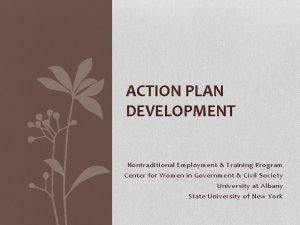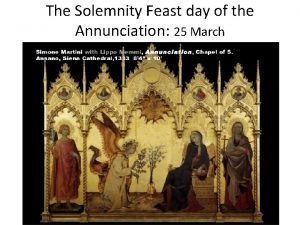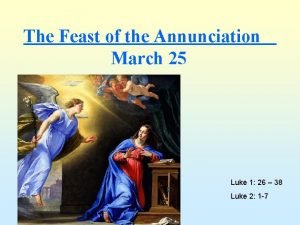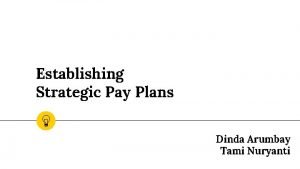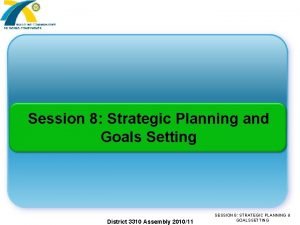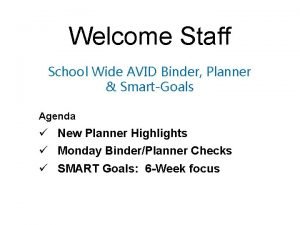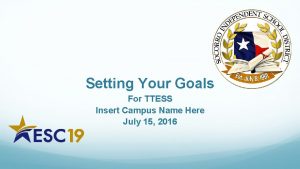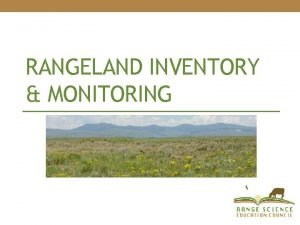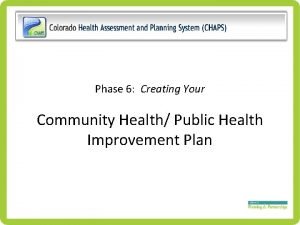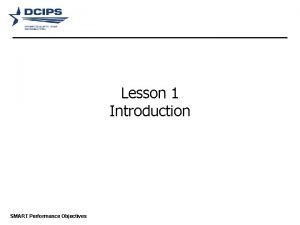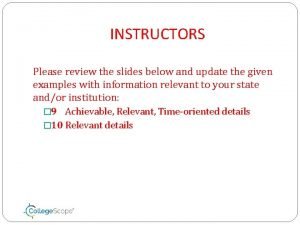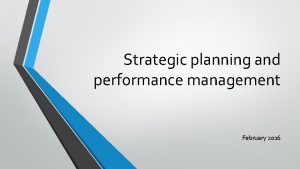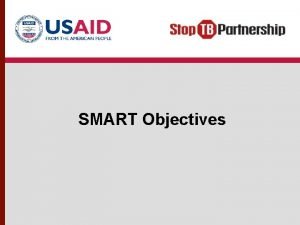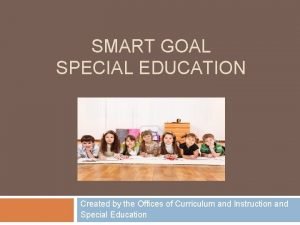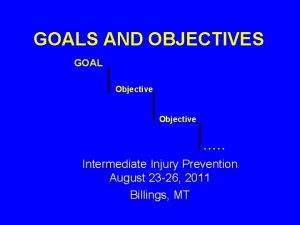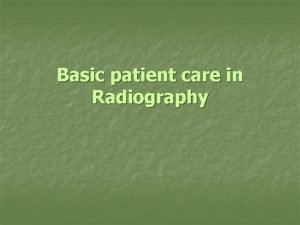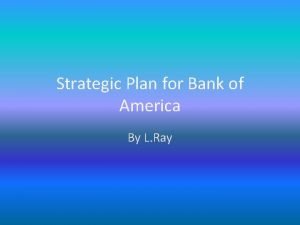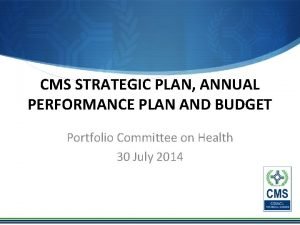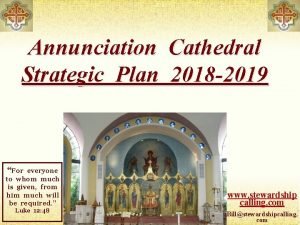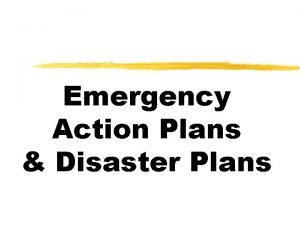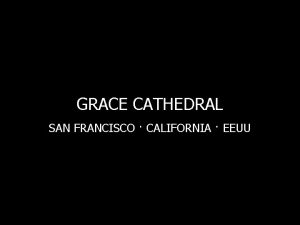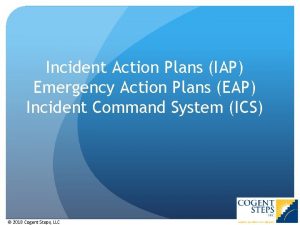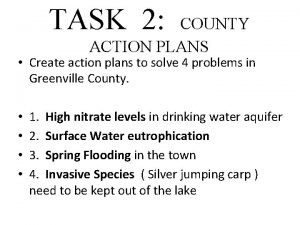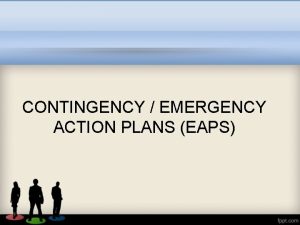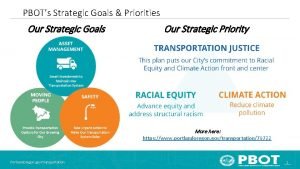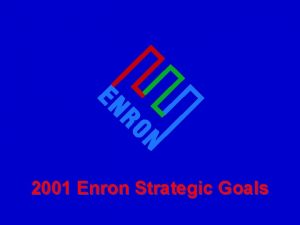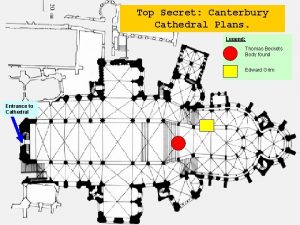Annunciation Cathedral SMART Strategic Goals and Action Plans















































- Slides: 47

Annunciation Cathedral SMART Strategic Goals and Action Plans ~ ~ ~ ~ ~ “Where there is no vision, the people will perish” Proverbs 29: 18 Bill Marianes – January, 2019 www. stewardshipcalling. com Bill@stewardshipcalling. com

Strategic Areas of Focus (alpha order) 1. Campus Improvements 2. Church Life Experience, Worship & Hospitality 3. Communication & Technology 4. Education 5. Leadership, Management & Operations 6. Life Stage Ministries 7. Partnerships, Outreach & Evangelism 8. Stewardship

Strategic Goals Campus Improvements 1. 1 – Accessibility, Athletic & Storage Facility Improvements Church Life Experience, Worships & Hospitality 2. 1 – Welcoming and Newcomer Ministries 2. 2 – Worship and Sacramental Engagement Communications & Technology 3. 1 – Communications and Technology Platform

Strategic Goals Education 4. 1 – Adult Education 4. 2 – Youth Education Leadership Management & Operations 5. 1 – Orthodox Servant Leadership Program 5. 2 – Operational Excellence

Strategic Goals Life Stage Ministries 6. 1 – Small Groups 6. 2 – Life Stage Ministries Philanthropy, Outreach and Philanthropy Ministry 7. 1 – Philanthropy Ministry Stewardship 8. 1 – Comprehensive Stewardship Program

Campus Improvements Goal 1. 1 Campus Improvements (a) Within 15 month, we will determine the projected costs, timelines, obtain necessary approvals and prioritize a Master Plan for the most critical Cathedral Campus improvements, including improved: (i) facilities more accessible to individuals with disabilities; (ii) outdoor facilities; (iii) storage facilities; and (iv) signage. (b) Within 2 years thereafter, we will raise the necessary funds and complete the prioritized improvements based on the established timelines.

Campus Improvements Goal 1. 1 Action Plan Specific Key Actions Necessary To Achieve Goal 1. 1 Who Must Do Each Action 1. Form Campus Improvements Goal 1. 1 Task Force (“CI 1. 1 TF”). Strategic Planning Team and Goal Captain Timetable: How Many Months or How Will We Know Days To Finish When This Action From Has Been Completed Previous Action 1 month from Start Date CI 1. 1 TF team members agree to serve 2. Research and identify accessibility, athletic and CI 1. 1 TF storage facility projects (“Master Plan Projects”) needs throughout our campus by (a) conducting an on-site assessment with appropriate legal and facilities experts; (b) developing outreach tools (e. g. , survey, focus groups, etc. ) to receive feedback from community concerning Master Plan Projects needs; and (c) reviewing existing documentation on previous efforts to identify necessary improvements. 4 months after step 1 Completed on-site assessment, survey/focus group findings compiled in centralized format, existing documentation compiled a notebook of Master Plan Projects. 3. Establish criteria for prioritization and then Parish Council and prioritize Master Plan Projects list identified in step CI 1. 1 TF 2 (e. g. , critical, necessary, desirable, etc. ) and establish a proposed implementation timeline. 1 month after step 2 4. Create preliminary design drawings and CI 1. 1 TF research cost estimates for each prioritized Master Plan Project and compile comprehensive Master Plan Project Plan with all projects prioritized, costed and having proposed timelines. 5 months after step 3 Estimated costs and timelines determined and Master Plan Project Plan developed Proposed prioritization of Master Plan Projects completed

Campus Improvements Goal 1. 1 Action Plan Specific Key Actions Necessary To Achieve Goal 1. 1 Who Must Do Each Action Timetable: How Many Months or How Will We Know Days To Finish When This Action From Has Been Completed Previous Action 5. Obtain first Parish Council and then General CI 1. 1 TF and Parish 4 months after step 4 Required Parish Council, Assembly (and any other required approvals (e. g. , Council and General Assembly and Metropolis, county, etc. )). Assembly other approvals all obtained 6. Work collaboratively with Parish Council and CI 1. 1 TF and Parish community to conduct feasibility study and Council procure necessary funding for approved prioritized Master Plan Projects. 10 months after step Master Plan Project funds 5 are raised 7. Work collaboratively with Parish Council and CI 1. 1 TF and Parish appropriate Parish authorities responsible for Council project management (e. g. , finalize the design plans and design and construction bid process and permits, and the construction process, etc. ) as necessary and appropriate to monitor progress and ensure timely and proper completion. 6 months after step 6 Periodic project reports and presented to Parish Council 8. Supervise completion of construction on identified Master Plan Projects. CI 1. 1 TF and Parish Council 7 months after step 7 Construction, including punch list items is complete and Parish accepts work 9. Conduct after completion review on all Master Plan Projects and processes and document lessons learned. CI 1. 1 TF and Parish Council 1 month after step 7 Master Plan Project final report submitted to Cathedral community

Church Life Experience, Worship & Hospitality Goal 2. 1 Welcoming and Newcomer Ministries Within 13 months, we will develop and implement a Welcoming and Newcomer Ministry that ensures that all, including visitors and newcomers, are fully welcomed and engaged in the life and ministries of the Parish and the Sunday experience.

Church Life Experience, Worship & Hospitality Goal 2. 1 Action Plan Timetable: How Many Months or Days To Finish Action From Previous Action How Will We Know When This Action Has Been Completed Specific Key Actions Necessary To Achieve Goal 2. 1 Who Must Do Each Action 1. Form Church Life Experience, Worship & Hospitality Goal 2. 1 Task Force (CLEWH 2. 1 TF). Strategic Planning Team and Goal Captain 1 month from Start Date CLEWH 2. 1 TF team members agree to serve 2. Research most effective best practices regarding church welcoming, hospitality and newcomer ministries from both non-Orthodox and Orthodox churches (including visiting other successful churches) and determine appropriate welcoming best practices, and most effective hospitality metrics to collect and analyze. CLEWH 2. 1 TF 3 months after step 1 Research analysis report of welcoming, hospitality and newcomer processes and other best practices is completed Simultaneous with step 2 Comprehensive data collection plans, methodologies and tools created 3. Develop new data collection tools (e. g. , CLEWH 2. 1 TF surveys, personal interviews, web solicitations, and original research from other Orthodox and non-Orthodox sources) that will effectively capture church welcoming, hospitality and engagement barriers data and input with a consistent methodology from the widest possible spectrum of our church body and beyond (including people who do not currently attend, those that have only visited once, and those that have never visited before, youth, seniors, converts, young families, newlyweds, college students, Orthodox, non-Orthodox, friends that have never attended, etc. ).

Church Life Experience, Worship & Hospitality Goal 2. 1 Action Plan Timetable: How Many Months or Days To Finish Action From Previous Action How Will We Know When This Action Has Been Completed Specific Key Actions Necessary To Achieve Goal 2. 1 Who Must Do Each Action 4. Execute the data collection methods chosen from step 3 above, utilizing best practices in methods and tools to identify church welcoming and hospitality barriers and areas of improvement. CLEWH 2. 1 TF 2 months after step 3 Minimum acceptable level of data collected from each of the identified constituent groups 5. Compile research and data from steps 2 through 4, existing processes, best practices research and visitor’s experiences and review and analyze results and data and identify the elements of a best practices welcoming, hospitality and engagement ministry program (the “Welcoming and Newcomer Ministry Plan”) to be implemented. CLEWH 2. 1 TF 3 months after step 4 Data analysis is complete and Welcoming and Newcomer Ministry Plan is completed 6. Recruit and train Welcoming and Newcomer CLEWH 2. 1 TF Ministry team members using the Welcoming and Newcomer Ministry Plan. 3 months after step 5 Welcoming and Newcomer Ministry team recruited and trained 7. Implement Welcoming and Newcomer Ministry Plan. CLEWH 2. 1 TF 1 month after step 6 Schedule is maintained 8. At least every 6 months thereafter review and assess success against appropriate welcoming and hospitality best practices, continuous data collection and metrics identified in step 2 and refine the Welcoming and Newcomer Ministry Plan accordingly. CLEWH 2. 1 TF At 6 month intervals Semi-annual assessment and remediation of Welcoming and Newcomer Ministry Plan occurs, including public reporting of results from evaluation assessments.

Church Life Experience, Worship & Hospitality Goal 2. 2 Worship and Sacramental Engagement Within 20 months, we will develop and implement a plan and process that will more fully engage parishioners of all ages in an accessible and fulfilling Worship and Sacramental experience.

Church Life Experience, Worship & Hospitality Goal 2. 2 Action Plan Timetable: How Many Months or Days To Finish Action From Previous Action How Will We Know When This Action Has Been Completed Specific Key Actions Necessary To Achieve Goal 2. 2 Who Must Do Each Action 1. Form Church Life Experience, Worship & Hospitality Goal 2. 2 Task Force (“CLEWH 2. 2 TF”). Strategic Planning Team and Goal Captain 1 month from Start Date CLEWH 2. 2 TF team members agree to serve 2. Research most effective best practices regarding worship and church experience from both non-Orthodox and Orthodox churches (including visiting other successful churches) and determine appropriate best practices, and worship and church experience and most effective engagement metrics to collect and analyze. CLEWH 2. 2 TF 5 months after step 1 Research analysis report of worship and church experience and other best practices is completed Simultaneous with step 2 Comprehensive data collection plans, methodologies and tools created 3. Develop new data collection tools (e. g. , CLEWH 2. 2 TF surveys, personal interviews, web solicitations, and original research from other Orthodox and non-Orthodox sources) that will effectively capture church worship and church experience engagement barriers data and input with a consistent methodology from the widest possible spectrum of our church body and beyond (including people who do not currently attend, those that have only visited once, and those that have never visited before, youth, seniors, converts, young families, newlyweds, college students, Orthodox, non-Orthodox, friends that have never attended, etc. ).

Church Life Experience, Worship & Hospitality Goal 2. 2 Action Plan Timetable: How Many Months or Days To Finish Action From Previous Action How Will We Know When This Action Has Been Completed Specific Key Actions Necessary To Achieve Goal 2. 2 Who Must Do Each Action 4. Execute the data collection methods chosen from step 3 above, utilizing best practices in methods and tools to identify church engagement and accessibility barriers and areas of improvement. CLEWH 2. 2 TF 4 months after steps 2 & 3 Minimum acceptable level of data collected from each of the identified constituent groups 5. Compile research and data from steps 2 through 4, existing processes, best practices research and visitors’ experiences and review and analyze results and data and identify best practices in worship and church experience engagement (the “Worship and Church Experience Plan”) to be implemented. CLEWH 2. 2 TF 3 months after step 4 Data analysis is complete and Worship and Church Experience Plan is developed 6. Prioritize the implementation schedule for the Worship and Church Experience Plan and identify any financial or other resources or approvals needed to fully implement them according to an agreed-upon implementation schedule. CLEWH 2. 2 TF 2 months after step 5 Worship and Church Experience Plan implementation is prioritized 7. Develop a strategy, detailed action plan and timeline to address prioritized list of worship and church experience barriers and opportunities per the Worship and Church Experience Plan (and raise any necessary funds or obtain any other required resources). CLEWH 2. 2 TF 4 months after step 6 Each barrier has a written action plan as well as the expected timeline to implement the solution 8. Implement Worship and Church Experience Plan action plans. CLEWH 2. 2 TF Beginning 1 month after step 7 Worship and Church Experience Plan action plans are implemented

Church Life Experience, Worship & Hospitality Goal 2. 2 Action Plan Timetable: How Many Months or Days To Finish Action From Previous Action How Will We Know When This Action Has Been Completed Specific Key Actions Necessary To Achieve Goal 2. 2 Who Must Do Each Action 9. Announce/publicize the completion of each implementation as a “win” to help create momentum and support. CLEWH 2. 2 TF Ongoing during step 8 Communicated via master communication plan 10. At least every 6 months thereafter review and assess success against appropriate worship and church experience engagement best practices metrics identified in step 2 and refine the Worship and Church Experience Plan accordingly. CLEWH 2. 2 TF 6 months cycle Assessment of Worship and Church Experience Plan and remediation occurs at least annually

Communications & Technology Goal 3. 1 Communications and Technology Platform Within 21 months, we will create and implement an enhanced communications process plan, Cathedral branding strategies and secure technology platform that will enable all parishioners to have 100% online access to our Parish services, ministries and other resources, information, tools and materials that will allow us to: (a) have at least 70% of our stewards engaging and donating using our online engagement platform within 12 months thereafter; (b) consistently achieve at least a 75% parishioner satisfaction level with this technology platform within 6 months thereafter; and (c) develop and roll out a consistent and effective brand for the Cathedral and its ministries

Communications & Technology Goal 3. 1 Action Plan Timetable: How Many Months or Days To Finish Action From Previous Action How Will We Know When This Action Has Been Completed C&T 3. 1 TF members agree to serve Specific Key Actions Necessary To Achieve Goal 3. 1 Who Must Do Each Action 1. Form Communications & Technology Goal 3. 1 Task Force (“C&T 3. 1 TF”). Strategic Planning Team and Goal Captain 1 month from Start Date 2. Research most effective church communications, branding strategies and technology resources, software, information, tools, and the best practices that churches and other non-profits use to connect with, and communicate to their parishioners and stakeholders. C&T 3. 1 TF 4 months after step 1 Report of most effective church communications and technology resources, information, tools and best practices is completed 3. Create, collect and determine metrics to measure parishioner use of and satisfaction with current website, online engagement and giving processes and communication channels, and other desirable ways to access our Parish and other services, information, processes and ministries. C&T 3. 1 TF Simultaneous with step 2 4. (a) Analyze survey results from step 3; (b) begin C&T 3. 1 TF developing branding materials; and (c) audit all current technology, communications process and all software capabilities (including, website, video broadcast, social media accounts, telephony, phone tree) compared against best practices established in step 2. At least 20% of Parishioners respond to survey and report of survey results is summarized 4 months after step 2 Report summarizing status of capabilities of current resources and processes and preliminary branding materials is produced

Communications & Technology Goal 3. 1 Action Plan Specific Key Actions Necessary To Achieve Goal 3. 1 Who Must Do Each Action Timetable: How Many Months or Days To Finish Action From Previous Action How Will We Know When This Action Has Been Completed 5. Interview stakeholders (clergy, office staff, C&T 3. 1 TF ministry chairs and all demographics of parishioners) that produce or consume Parish services, communications and technology resources and work with our staff to research and identify the capabilities and gaps of our existing software and how our engagement and giving is processed. Simultaneous with step 4 Report summarizing stakeholder interviews and giving processes and any underutilized software features and gap analysis is produced 6. Finalize (the “Communication & Technology C&T 3. 1 TF Plan”) consisting of : (a) branding materials; (b) research and identification of potential alternative technology solutions enabling broadcast and dissemination of church services and creation of a communications hub to allow for content creators (clergy, office staff, ministry chairs) to create and target and deliver communications to parishioners through all channels; and (c) comprehensive recommendations, budget and implementation timeline in all areas of communications, online engagement and giving and technology, including appropriate metrics to evaluate and determine success. 4 months after step 5 Communication & Technology Plan is finally developed (in cooperation with the Task Force working on Operational Excellence Strategic Goal 5. 2)

Communications & Technology Goal 3. 1 Action Plan Specific Key Actions Necessary To Achieve Goal 3. 1 Who Must Do Each Action Timetable: How Many Months or Days To Finish Action From Previous Action How Will We Know When This Action Has Been Completed 7. Obtain (a) any necessary budgetary, Parish C&T 3. 1 TF, Clergy Council, General Assembly or other approvals for and Parish Council Communication & Technology Plan recommendations; and (b) any necessary funding. 6 months after step 6 Necessary approvals and budgets are obtained 8. Establish governance, guidelines and monitoring processes for properation and use of all communications and engagement technology solutions. Simultaneously with Governance, guidelines step 7 and monitoring processes document is created and approved C&T 3. 1 TF, Clergy and Parish Council 9. Procure the products, systems, technical and C&T 3. 1 TF, Clergy facility resources, human resources necessary to and Parish Council implement the Communications & technology Plan. 1 month after steps 7 Procurement and preand 8 implementation checklist is fully acquired and complete 10. Begin implementation of Communication & C&T 3. 1 TF Technology Plan based on implementation timeline, including enhanced online engagement and giving and access to other church services and self-service communications hub (“Communications Hub”) to allow parishioners to subscribe to the communications channels they wish to receive. 1 months after step 9 Communication & Technology Plan and Communications Hub roll out begins

Communications & Technology Goal 3. 1 Action Plan Specific Key Actions Necessary To Achieve Goal 3. 1 Who Must Do Each Action 11. Semi-annual parishioner survey and independent review, evaluation, update and changes in Communication & Technology Plan and Communications Hub to ensure that all elements are the most effective best practices available and ensure achievement of the targets of: (a) 70% of our stewards engaging and donating using our online engagement platform; and (b) at least a 75% parishioner satisfaction level with this engagement technology platform. C&T 3. 1 TF Timetable: How Many Months or Days To Finish Action From Previous Action Beginning 6 months after step 10 and every 6 months thereafter How Will We Know When This Action Has Been Completed Semi-Annual assessment of Communication & Technology Plan and Communications Hub is completed at least every 6 months and appropriate changes are implemented

Education Goal 4. 1 Adult Religious Education Within 21 months, we will develop and implement an effective, comprehensive and interactive full-year Adult Religious Education Program that will be successfully delivered to a minimum of 30% of adult parishioners over the next 2 years thereafter.

Education Goal 4. 1 Action Plan Timetable: How Many Months or Days To Finish Action From Previous Action How Will We Know When This Action Has Been Completed Specific Key Actions Necessary To Achieve Goal 4. 1 Who Must Do Each Action 1. Form Education Goal 4. 1 Task Force (E 4. 1 TF). E 4. 1 TF 1 month from start date E 4. 1 TF team members agree to serve 2. Compile and send survey to community for input on most needed and desired adult religious education and spirituality topics, information and curriculum. E 4. 1 TF 4 months after step 1 Surveys returned and responses are compiled 3. Conduct comprehensive research to determine best in class adult religious and spiritual education materials, content, programs, delivery options and best practices from both Orthodox and non-Orthodox sources (including reviewing existing Metropolis of Atlanta strategic plan religious education materials and other offerings from Orthodox Parish Priests and Religious Education Directors) and specifically identify objective evidence of the effectiveness of each. E 4. 1 TF Simultaneous with step 2 All materials are researched including objective evidence of effectiveness 4. Qualitatively analyze and assess: (a) all researched and submitted educational materials and categorize them according to topics and objective evidence of their effectiveness and create a comprehensive list of topics and best in class content; (b) assess community survey data of needed and desired adult religious education and spirituality topics and information; and (c) best alternative methods for delivery of adult religious education content. E 4. 1 TF 4 months after step 3 Comprehensive report completed of qualitive analysis of all content / materials, community survey and alternative delivery systems 5. Finalize outline of comprehensive “Adult Religious Education Program” and delivery schedule and methods to identify gaps in the Program and the process and timeline for specifically filling such gaps, including who is responsible for achieving each step within the established timeline (“Gap Analysis Workplan”). E 4. 1 TF 3 months after step 4 Adult Religious Education Program and Gap Analysis Workplan is complete

Education Goal 4. 1 Action Plan Specific Key Actions Necessary To Achieve Goal 4. 1 Who Must Do Each Action Timetable: How Many Months or Days To Finish Action From Previous Action How Will We Know When This Action Has Been Completed 6. Research, gather, revise, develop, and/or solicit the development of E 4. 1 TF additional materials needed for missing areas, or areas that do not meet best practices, or most effective standard as determined through Gap Analysis Workplan, including replacing those materials that are deemed ineffective. 4 months after step 5 Gap Analysis Workplan is executed and gaps are filled 7. Recruit and train any additional appropriate persons needed to most effectively deliver the content for the Adult Religious Education Program. E 4. 1 TF 4 months after step 6 Additional educators agree to serve and are trained 8. In conjunction with Communications and Technology Task Force, establish online, video and/or alternative platform for delivery of Adult Religious Education Program, including a format for peer review and commentary, as well as a process to submit newer and more effective materials, and load best practices education materials onto Metropolis of Atlanta Portal Spiritual Growth Resources. E 4. 1 TF Simultaneous with steps 6 and 7 Online and video delivery options established and best practice materials for the various topics are loaded on the Metropolis Portal 9. Begin promotion of Adult Religious Education Program and establish process to sign up as many adults as possible with the goal of participation from 30% of our adults. E 4. 1 TF Simultaneous with step 7 Communication and sign-up of participants occurs 10. Begin official roll out of Adult Religious Education Program. E 4. 1 TF 1 month after step 9 Program is officially rolled-out 11. Create and implement a regularly scheduled evaluation plan for reviewing the performance and effectiveness of all Adult Religious Education Program materials after each delivery and make improvements based on results of evaluation. E 4. 1 TF Beginning after each Program is delivered Evaluations reviewed and improvements made in each element of Adult Religious Education Program 12. Semi-annual review, evaluation and update of all materials, presenters, and entire Adult Religious Education Program to ensure that all materials and presenters are the most effective best practices available and the target of 30% of adults having completed the program is achieved. E 4. 1 TF Semi-annual review Semi-Annual assessment is complete, improvements implemented and 30% adult target is achieved

Education Goal 4. 2 Youth Religious Education Within 21 months, we will determine the applicable metrics to ensure that our Sunday School curriculum is effective, and design and implement such an effective K-12 curriculum that reaches and engages at least 60% of our youth.

Education Goal 4. 2 Action Plan Timetable: How Many Months or Days To Finish Action From Previous Action How Will We Know When This Action Has Been Completed Specific Key Actions Necessary To Achieve Goal 4. 2 Who Must Do Each Action 1. Form Education Goal 4. 2 Task Force (E 4. 2 TF). E 4. 2 TF 1 month from start date E 4. 2 TF team members agree to serve 2. Conduct comprehensive research from all available sources to determine how to measure properly the effectiveness of church religious education programs and materials for youth and establish an “Effectiveness Measurement Methodology and Process” to test the effectiveness of our youth religious education programs. E 4. 2 TF 4 months after step 1 Effectiveness Measurement Methodology and Process Report is completed 3. Conduct comprehensive research to determine best in class religious and spiritual education materials, content, programs, delivery options and best practices from both Orthodox and non. Orthodox sources (including site visits to successful churches and reviewing existing Metropolis of Atlanta strategic plan religious education materials and other offerings from Orthodox Parish Priests and Religious Education Directors) and specifically identify objective evidence of the effectiveness of each. E 4. 2 TF simultaneous with step 2 All materials are researched including objective evidence of effectiveness based on Effectiveness Measurement Methodology and Process 4. Qualitatively analyze and assess: (a) all researched and submitted educational materials and categorize them according to topics and objective evidence of their effectiveness and create a comprehensive list of topics and best in class content; (b) all content against the Effectiveness Measurement Methodology and Process to determine the most effective content; and (c) best alternative methods for delivery of most effective youth religious education content. E 4. 2 TF 4 months after step 3 Comprehensive report completed of qualitive analysis of all content/materials, and alternative delivery systems 5. Finalize outline of comprehensive “Youth Religious Education Program” and delivery schedule and methods to identify gaps in the Program and the process and timeline for specifically filling such gaps, including who is responsible for achieving each step within the established timeline (“Gap Analysis Workplan”). E 4. 2 TF 3 months after step 4 Youth Religious Education Program and Gap Analysis Workplan is complete

Education Goal 4. 2 Action Plan Specific Key Actions Necessary To Achieve Goal 4. 2 Who Must Do Each Action Timetable: How Many How Will We Know Months or When This Action Has Days To Been Completed Finish Action From Previous Action 6. Research, gather, revise, develop, and/or solicit the E 4. 2 TF development of additional materials needed for missing areas that do not meet best practices, or most effective standard as determined through Gap Analysis Workplan, including replacing those materials that are deemed ineffective. 4 months after step 5 Gap Analysis Workplan is executed and gaps are filled 7. Recruit and train appropriate teachers needed for the most effective delivery of the Youth Religious Education Program. E 4. 2 TF 4 months after step 6 Additional teachers agree to serve and are trained 8. Begin official roll out of Youth Religious Education Program. E 4. 2 TF 1 month after step 7 Youth Religious Education Program is officially rolled-out 9. In conjunction with the Communications and Technology Committee, establish and implement alternative online, video and/or other platform for delivery of Youth Religious Education Program, including a format for peer review and commentary, as well as a process to submit newer and more effective materials, . E 4. 2 TF Simultaneous with steps 7 and 8 Online, video or alterative delivery options established and implemented 10. Semi-annual review, evaluation and update of all materials, teachers, and entire Youth Religious Education Program to ensure that all materials are the most effective best practices available and the target of 60% of Youth having effectively completed the Youth Religious Education Program is achieved. E 4. 2 TF Semi-annual review Semi-Annual assessment of Youth Religious Education Program is complete, improvements are implemented and 60% Youth target is achieved

Leadership, Management & Operations Goal 5. 1 Orthodox Servant Leadership Program Within 12 months, we will develop and implement a comprehensive and effective Orthodox Servant Leadership training and development program that will be mandatory for all Parish Council members, Ministry Leaders and youth leaders.

Leadership, Management and Operations Goal 5. 1 Action Plan Timetable: How Many Months or Days To Finish Action From Previous Action Specific Key Actions Necessary To Achieve Goal 5. 1 Who Must Do Each Action 1. Form Leadership, Management & Operations Goal 5. 1 Task Force (“LMO 5. 1 TF”). Strategic 1 month from Start Planning Date Team & Goal Captain How Will We Know When This Action Has Been Completed LMO 5. 1 TF team members agree to serve 2. Research and identify best practices in: (a) Servant LMO 5. 1 TF Leadership (both inside and outside the Orthodox church, including the Metropolis of Atlanta Orthodox Leadership Training program); (b) identify key leadership skill elements and gaps which need to be filled (shaped by the our values, mission, vision and goals); and (c) develop interview questions for participants in steps 3 and 4. 3 months after step 1 Research is completed and best practices summary report generated, including elements of Metropolis Training Program that can be used 3. Identify and interview adults already in Parish LMO 5. 1 TF leadership positions and discuss their skills, experiences and what they believe would help improve their performance and our Parish now and into the future. 3 months after step 2 Summaries of adult 4. Identify and interview youth, as well as other adults who show leadership potential, and assess what developmental areas that would help them or would be required by them in order to step into leadership positions in the near future. Simultaneous with step 3 LMO 5. 1 TF leadership interviews are completed and compiled Interviews of youth and adult leaders are completed and compiled

Leadership, Management and Operations Goal 5. 1 Action Plan Timetable: How Specific Key Actions Necessary To Achieve Goal 5. 1 Who Must Do Each Action 5. From all available research, resources and LMO 5. 1 TF materials (including the work done in steps 2 -4), develop Leadership Program training for all 4 tiers (the “ 4 Tiers”): (a) Parish Council Many Months or Days To Finish Action From Previous Action How Will We Know When This Action Has Been Completed 4 months after step 4 Training program created for all 4 Tiers of Leadership Program members; (b) Ministry Leaders and Endowment members; (c) future leaders; and (d) youth leaders, that at least includes core management skills (planning, process, people, budgets, reporting, etc. ), and leadership skills (team building, coaching and visioning, negotiation, conflict resolution, communication, etc. ). 6. Establish a schedule for, and begin to regularly deliver, Leadership Program training to all 4 Tiers, with any candidate for Parish Council or Ministry Leadership being required to receive the training before they can serve in such capacities. LMO 5. 1 TF 1 month after Training for all 4 Tiers is step 5 conducted on set schedule 7. After every Leadership Training program perform an assessment of its effectiveness and identify areas for improvement and make necessary course corrections, LMO 5. 1 TF After each program Assessments are completed after every program and at least annually and improvements are implemented 8. At least annually, comprehensively assess the effectiveness of the entire Leadership Training Program for all 4 Tiers to ensure that all materials are the most effective best practices available and the target level of mandatory training is achieved. LMO 5. 1 TF At least annual review At least annual assessment of Leadership Training Program is completed, improvements are implemented and training

Leadership, Management & Operations Goal 5. 2 Operational Excellence (a) Within 20 months, we will identify the most critical operations, processes and staffing, assess them against agreedupon, best-practices, and make improvement recommendations; and (b) Within 1 year thereafter, we will train all relevant individuals on how to properly implement and measure progress so that we achieve the agreed-upon percentage improvement in each operation and process.

Leadership, Management and Operations Goal 5. 2 Action Plan Timetable: How Many Months or Days To Finish Action From Previous Action How Will We Know When This Action Has Been Completed Specific Key Actions Necessary To Achieve Goal 5. 2 Who Must Do Each Action 1. Form Leadership. Management & Operations Goal 5. 2 Task Force (“LMO 5. 2 TF”). Strategic Planning 1 month from Start LMO 5. 2 TF team members Team and Goal Date agree to serve Captain 2. Obtain and review existing documentation about our LMO 5. 2 TF current operations and processes of management of the Parish and its ministries and key operations (including Hellenic Center, but excluding ADS). 5 months after step 1 3. Research best practices for church administration LMO 5. 2 TF operations, and staffing from other religious (Orthodox and non-Orthodox) and non-profit organizations. Simultaneous with Research of best step 2 practices is 4. Survey our community regarding assessments of our operating performance in key identified areas and suggestions for improvement and analyze results. LMO 5. 2 TF Complete review of current operations, processes and management and compile report of key findings completed and report of key elements is compiled 4 months after step 3 Survey completed analyzed and report of key findings is compiled

Leadership, Management and Timetable: How Operations Goal 5. 2 Action Plan Specific Key Actions Necessary To Achieve Goal 5. 2 Who Must Do Each Action 5. Identify and interview all key (clergy and nonclergy) employee staff and volunteers and: (a) LMO 5. 2 TF discuss their skills, experiences, challenges; (b) what they believe would help improve their performance and the Parish; (c) conduct risk assessment of organization structure and identify key roles and any gaps in bench strength or succession planning that place the viability of major church initiatives at risk; and (d) identify a best practices annual review process for key roles (except Many Months or Days To Finish Action From Previous Action How Will We Know When This Action Has Been Completed Simultaneous with Key interviews step 4 are completed and report of summary of key findings is compiled for clergy) and evaluate progress in implementing succession plan recommendations. 6. Map each area’s and operation’s current workflow and LMO 5. 2 TF procedures and related available metrics and: (a) identify key operational metrics and key performance indicators (“KPIs”) to assess in each area of operations; (b) current levels of KPIs performance in each area; (c) achievable desired percentage performance KPIs improvements; and (d) timeline to achieve them (the “Operational Metrics Plan”). 3 months after step Operational Metrics 5 Plan is completed 7. From all available resources, materials, research, surveys LMO 5. 2 TF 3 months after step Draft Operations 6 Improvement Plan is completed and interviews (including the work done in steps 2 -6) create “Operations Improvement Plan” to include at least: (a) finalized Operational Metric Plan; (b) employee and volunteer staffing job descriptions, development, training, succession and needs plan (the “Staffing Plan”); (c) other key recommendations to improve our operations and service of parishioners; (d) a shared dashboard (the “Dashboard”) with regular cadence for reporting the KPIs for each area.

Leadership, Management and Operations Goal 5. 2 Action Plan Specific Key Actions Necessary To Achieve Goal 5. 2 Who Must Do Each Action 8. Submit draft Operations Improvement Plan LMO 5. 2 TF and Parish Council for approval of the Parish Council and work with Parish Council to reach consensus on final Operations Improvement Plan. Timetable: How Many Months or How Will We Know Days To Finish When This Action From Has Been Completed Previous Action 3 months after step 7 Final Operations Improvement Plan is approved by Parish Council 9. Begin implementation of Final Operations LMO 5. 2 TF, Parish Council and other Improvement Plan, including: (a) regular public identified reporting of Dashboard of KPIs; and (b) at least annually conduct talent performance development stakeholders assessments privately for employees and volunteers. Beginning 1 month after step 8 and continuously thereafter Implementation begins, Dashboard KPIs are regularly publicly reported annual private talent assessments are completed 10. At least annually assess the Operations LMO 5. 2 TF and Parish Council Improvement Plan against actual experience and evolving best practices and make necessary adjustments and improvements. 1 year after step 9 and annually thereafter Annual assessment of Operations Improvement Plan is completed and improvements are implemented

Life Stage Ministries Goal 6. 1 Small Groups Within 21 months, we will develop and implement an effective Small Group Program that within 3 years thereafter will include at least 100 of our families.

Life Stage Ministries Goal 6. 1 Action Plan Specific Key Actions Necessary To Achieve Goal 6. 1 Who Must Do Each Action 1. Form Life Stage Ministries Goal 6. 1 Task Force (“LSM 6. 1 TF”). LSM 6. 1 TF Timetable: How Many Months or Days To Finish Action From Previous Action How Will We Know When This Action Has Been Completed 1 month from start LSM 6. 1 TF team date members agree to serve 2. Conduct comprehensive research to find best practices in Small LSM 6. 1 TF Group programs (including making site visits and interviews of those who have successfully implemented this program), and closely examine and investigate what has worked, what has not, what lessons have been learned and what resources are available to facilitate a Small Group Program, and specifically identify objective evidence of effectiveness. 3 months after steps 1 All materials are researched including objective evidence of effectiveness 3. Qualitatively analyze and assess all researched Small Group program materials and resources, results of personal site visits and objective evidence of their effectiveness, and create a comprehensive list of topics and best in class content and best alternative methods for delivery and logistics. LSM 6. 1 TF 2 months after step Complete 3 comprehensive report of Small Group research and site visits analysis 4. Compile, distribute and process survey, interviews and data LSM 6. 1 TF collection techniques to our community for input on willingness to participate in a Small Group, and obtain feedback on logistics, methodology to maximize attendance and participation, including desired topics, frequency, information and curriculum. 4 months after step Surveys returned and 3 responses are compiled 5. Using all of the research compiled in steps 2 through 4, create a LSM 6. 1 TF comprehensive “Small Group Program” and delivery schedule and methods and identify materials and curriculum gaps and the process and timeline for specifically filling such gaps, including who is responsible for achieving each step within the established timeline (“Gap Analysis Workplan”). 3 months after step Small Group Program 4 Gap Analysis Workplan is complete

Life Stage Ministries Goal 6. 1 Action Plan Specific Key Actions Necessary To Achieve Goal 6. 1 Who Must Do Each Action Timetable: How Many Months or How Will We Know When Days To Finish This Action Has Been Action From Completed Previous Action 6. Research, gather, revise, develop, and/or solicit the development LSM 6. 1 TF of additional materials needed for missing areas, or areas that do not meet best practices or most effective standard as determined through Gap Analysis Workplan, and complete Small Group Program curriculum and process. 2 months after step 5 Gap Analysis Workplan is executed and gaps are filled and Small Group Program curriculum and process is finalized 7. Recruit and train at least 5 Small Group leaders on how to most effectively lead small groups based on the Small Group Program. LSM 6. 1 TF 3 month after step 6 At least 5 Small Group Leaders agree to serve and are trained 8. Recruit sufficient parishioners to participate in at least 5 Small Groups to be formed by leaders trained in step 7 and provide them training on how the Small Group Program will be implemented. LSM 6. 1 TF 2 months after step 7 At least 5 Small Groups are formed and parishioners ate recruited and trained 9. Conduct pilot test of at least 5 Small Groups and conduct at least quarterly assessments of lessons learned and changes needed to ensure the greatest effectiveness and make appropriate improvements in Small Group Program. LSM 6. 1 TF Beginning 1 Pilot test assessment is and Small month after step completed continued on at Group Program 8 least a quarterly basis Leaders 10. Recruit and train additional Small Group leaders and expand recruitment of additional parishioners to participate in Small Group Program and continue to grow to achieve the target of at least 100 participating families. LSM 6. 1 TF and Small Group Program Leaders Continuously Additional Small Group occurring after Leaders and groups are step 9 formed until at least 100 families participate 11. Implement a regularly scheduled evaluation plan for reviewing the performance of all Small Groups and materials at least quarterly and make improvements based on results of evaluation to ensure that all materials are the most effective best practices available and the target of at least 100 participating families is achieved. LSM 6. 1 TF and Small Group Program Leaders At least quarterly assessment Evaluations occur and improvements are made in each element of Small Group Program

Life Stage Ministries Goal 6. 2 Life Stage Ministries Within 18 months, we will develop and implement a series of Life Stage Ministries to address the varied ministry needs of our singles, married couples, families, youth and seniors, that will include at least 50% of our parishioners within 3 years thereafter.

Life Stage Ministry Goal 6. 2 Action Plan Specific Key Actions Necessary To Achieve Goal Who Must Do Each Action 6. 2 Timetable: How Many Months or Days To Finish Action From Previous Action How Will We Know When This Action Has Been Completed 1. Form Life Stage Ministry Goal 6. 2 Task Force (“LSM 6. 2 TF”) Strategic Planning Team and Goal Captain 1 month from Start Date LCM 6. 2 TF team members agree to serve. 2. Conduct comprehensive research from all available sources to determine how to properly measure the effectiveness of church singles, married couples, family, youth & seniors ministries and programs (“Life Stage Ministries”) and establish a “Ministry Effectiveness Measurement Methodology and Process” to test the effectiveness of our Life Stage Ministries. LSM 6. 2 TF 6 months after step 1 Life Stage Ministries Effectiveness Measurement Methodology and Process Report is completed 3. Conduct comprehensive research to LSM 6. 2 TF determine best in class Orthodox and non. Orthodox Life Stage Ministry programs, materials, content, delivery options and best practices (“Best Practices”), including reviewing existing Metropolis of Atlanta strategic plan Life Stage Ministry materials, and specifically identify objective evidence of the effectiveness of each. 4. Together with existing Parish Life Stage Ministry leaders use Life Stage Ministries Effectiveness Measurement Methodology and Process and Best Practices to qualitatively analyze and assess all existing and researched Life Stage Ministry programs and materials (“Best Practices Report”) and identify gaps in existing our Life Stage Ministries (“GAP Analysis”). simultaneous with step All materials are researched 2 including objective evidence of effectiveness based on Life Stage Ministries Effectiveness Measurement Methodology and Process and Best Practices are defined LSM 6. 2 TF and existing Parish 4 months after step 3 Life Stage Ministry Leaders Complete comprehensive Best Practices Report of all existing and researched Life Stage Ministries Measurement Methodology and Process and Gap Analysis

Life Stage Ministry Goal 6. 2 Action Plan Specific Key Actions Necessary To Achieve Goal 6. 2 Timetable: How Many Months or Who Must Do Each Days To Finish Action From Previous Action How Will We Know When This Action Has Been Completed 5. Based on Best Practices Report and GAP Analysis LSM 6. 2 TF revise existing Life Stage Ministries and develop new Life Stage Ministry programs that meet or exceed Best Practices and establish timetable and action plan to achieve engagement of at least (50%) of our parishioners within 3 years. 6 months after step 4 Gap Analysis Workplan is executed and gaps are filled 6. Begin official roll out of new and revised Life Stage Ministry programs. LSM 6. 2 TF 1 month after step 5 New and revised Life Stage Ministry programs are officially rolled-out 7. Semi-annual review, evaluation and update of all Life Stage Ministries against Effectiveness Measurement Methodology and Process, Best Practices and progress toward achievement of goal of reaching at least (50%) of our parishioners within 3 years. LSM 6. 2 TF Semi-annual review Semi-Annual assessment of Life Stage Ministries is complete, improvements are implemented and 50% target is achieved

Philanthropy Goal 7. 1 Philanthropy Ministry Within 16 months, we will establish a vibrant Philanthropy Ministry, that within 8 months from formation will: (a) recruit at least 100 parishioners to participate in Parish Philanthropy Ministries and partnerships; (b) plan and execute at least one specific Parish Philanthropy Ministry event every four months, either alone or in partnership with another non-profit entity; (c) define and successfully implement at least one reoccurring signature Philanthropy Ministry program or event.

Philanthropy Ministry Goal 7. 1 Action Plan Timetable: How Many Months or Who Must Do Each Days To Finish Action From Previous Action How Will We Know When This Action Has Been Completed Strategic Planning Team and Goal Captain 1 month from Start Date POE 7. 1 TF team members agree to serve 2. Conduct comprehensive research to determine best-in. POE 7. 1 TF class Philanthropy methods, programs, activities, structure, success factors, volunteer recruitment strategies and effectiveness assessment tools from Orthodox, non. Orthodox and other non-profit organizations. 4 months after step 1 Philanthropy best practices report is completed 3. Develop a baseline inventory to identify: (a) all current POE 7. 1 TF and past Parish Philanthropy programs (and their perceived success); (b) other signature Philanthropy ministries and programs from other Christian or non-profit organizations which can either be copied or adapted or with whom partnerships can be established to pursue that ministry or program; and (c) philanthropy-minded parishioners to help coordinate Philanthropy ministries and activities. 4 months after step 2 Philanthropy baseline inventory is completed Specific Key Actions Necessary To Achieve Goal 7. 1 1. Form Philanthropy, Outreach and Evangelism (“POE”) Goal 7. 1 Task Force (“POE 7. 1 TF”).

Philanthropy Ministries Goal 7. 1 Action Plan Specific Key Actions Necessary To Achieve Goal 7. 1 Timetable: How Many Months or Who Must Do Each Days To Finish Action From Previous Action How Will We Know When This Action Has Been Completed POE 7. 1 TF 4 months after step 3 Parish Philanthropy survey information and interviews are collected 5. From all available resources, materials, research, POE 7. 1 TF surveys and interviews, identify, plan and obtain any necessary approvals for : (a) a quarterly schedule of Philanthropy events to be implemented by the Parish either alone or in partnership with another entity (the “Quarterly Philanthropy Events”); and (b) the most attractive Parish re -occurring signature Philanthropy program (the “Signature Philanthropy Program”); and develop strategy, budget, fundraising, mechanism, communications and implementation plan for all such Philanthropy programs, including dates, time and goals. . 3 months after step 4 Planning of recommended Quarterly Philanthropy Events and Signature Philanthropy Program is completed and ready for implementation 4. From among the many ideas generated from the research in steps 2 -3, survey the community and conduct some interviews in order to determine what areas of Philanthropy programs, ministries, activities and partnerships are most important to the Parish and will obtain the greatest participation and positive results.

Philanthropy Ministry Goal 7. 1 Action Plan Specific Key Actions Necessary To Achieve Goal 7. 1 Timetable: How Many Months or Who Must Do Each Days To Finish Action From Previous Action How Will We Know When This Action Has Been Completed 6. Present Quarterly Philanthropy Events and Signature Philanthropy Program to the Parish and continuously recruit until at least 100 parishioners participate in at least one of the Quarterly Philanthropy Events or Signature Philanthropy Program. POE 7. 1 TF 8 months after step 5 At least 100 Philanthropy volunteers are recruited and participate in at least one of the Quarterly Philanthropy Events or Signature Philanthropy Program 7. Successfully implement: (a) at least one Quarterly POE 7. 1 TF Concurrent with step 6 Quarterly Philanthropy Events and Signature Philanthropy Program are executed on schedule After every Quarterly Philanthropy Event and Signature Philanthropy Program and at least annually continuously thereafter. Signature Philanthropy, Program is evaluated and revised as needed, and success is determined Philanthropy Event every 3 months; (b) the Signature Philanthropy Program annually; and (c) publicize successes and results of events every 3 months. 8. Implement the Philanthropy effectiveness assessment tool POE 7. 1 TF to manage on-going effectiveness of the all Quarterly Philanthropy Events and the Signature Philanthropy Program, ensure alignment with overall Parish vision, and make necessary adjustments and improvements.

STEWARDSHIP Goal 8. 1 Comprehensive Stewardship Program Within 12 months, we will develop and implement a comprehensive new adult and youth Stewardship Program that will: (a) include personal interactions with all parishioners to be completed within 12 months after they begin; (b) result in a sustainable minimum 35% increase in financial stewardship contributions and a 35% increase in engagement of volunteers in ministries within 18 months thereafter; and (c) ensure that we fully fund our operating budget directly from parishioner Stewardship contributions within 3 years.

Stewardship Goal 8. 1 Action Plan Specific Key Actions Necessary To Achieve Stewardship Goal 8. 1 1. Recruit Stewardship Goal 8. 1 Task Force (“S 8. 1 TF"). Who Must Do Each Action Timetable: How Many Months or Days To Finish Action From Previous Action Stewardship Strategic 1 month after Start Planning Task Force Date and the Goal Captain 2. S 8. 1 TF meets and allocates work to: (a) review S 8. 1 TF the current Metropolis 15 -step Igniting the Flame of True Orthodox Christian Stewardship Program and determine what elements of that will be incorporated in the new Parish Stewardship Program (the “Stewardship Program"); (b) complete research of other stewardship best practices that can be implemented, including specifically a youth stewardship program; (c) compile detailed stewardship data from the last 3 years. 3. Complete the assessment of the research in the S 8. 1 TF previous step 2, including determination of what constitutes best practices and finalize all of the stewardship data analysis from the last 3 years. 4. Synthesize current stewardship best practices, S 8. 1 TF best of the current Metropolis Igniting the Flame of True Orthodox Stewardship Program to develop the new official Parish Stewardship Program that will include personal interactions and “Other Elements” (e. g. , youth stewardship, planned giving, thanking ministry, etc. ) How Will We Know When This Action Has Been Completed S 8. 1 TF members agree to serve 3 months after step 1 Meeting has occurred and re-tooling process and best practices research has started 2 months after step 2 Assessment and research is complete 2 months after step 3 New and improved Stewardship Program has been developed and begins to be implemented

Stewardship Goal 8. 1 Action Plan Timetable: How Many Months or Days To Finish Action From Previous Action How Will We Know When This Action Has Been Completed Specific Key Actions Necessary To Achieve Stewardship Goal 8. 1 Who Must Do Each Action 5. Recruit Stewardship Team (the “Stewardship Team”) to conduct the personal interactions with the parishioners. S 8. 1 TF 2 months after step 4 Stewardship Team have accepted responsibility 6. Train the Stewardship Team on the process to be used for the personal interactions. S 8. 1 TF 2 months after step 5 All Stewardship Team members have been trained 7. Begin the personal interaction process and S 8. 1 TF and reach: (a) 100% of previous stewards; and Stewardship (b) at least 20% of former (non-current) Team stewards from the last 3 years, per year for each of the next three years. 3 months after step 6 Personal interaction has been completed with all parishioners and target former stewards 8. After all personal interactions are complete, conduct a detailed analysis of the results, commitments obtained and lessons learned, and determine what changes should be implemented in the next round of personal interactions. 2 months after step 7 Assessment is complete and changes are agreed upon and implemented in next round of interactions S 8. 1 TF and Stewardship Team

Stewardship Goal 8. 1 Action Plan Timetable: How Many Months or Days To Finish Action From Previous Action How Will We Know When This Action Has Been Completed Specific Key Actions Necessary To Achieve Stewardship Goal 8. 1 Who Must Do Each Action 9. Begin initiation of the other elements that comprise the final approved Stewardship Program as determined in Step 4 beyond the personal visitations (the “Other Elements”). S 8. 1 TF and Stewardship Team Concurrent with steps 5 and 6 Each Other Element is initiated 10. Conduct follow-up assessment of each S 8. 1 TF and of Other Elements and corresponding Stewardship successes, challenges and revise the Team Other Elements accordingly. At least 6 months after implementation of step 9 and continuously every three months thereafter Other Element assessment is completed and changes are agreed upon and implemented
 Chartres cathedral painting
Chartres cathedral painting Groin vault vs rib vault
Groin vault vs rib vault Strategic goals tactical goals operational goals
Strategic goals tactical goals operational goals Strategic goals tactical goals operational goals
Strategic goals tactical goals operational goals Examples of goals, objectives and action plans
Examples of goals, objectives and action plans Why did ghiberti win the competition
Why did ghiberti win the competition Annunciation of the birth of jesus
Annunciation of the birth of jesus The annunciation feast day
The annunciation feast day Giovanni bellini annunciation
Giovanni bellini annunciation Joyful mystery the annunciation
Joyful mystery the annunciation Sandro botticelli famous paintings
Sandro botticelli famous paintings The annunciation march 25
The annunciation march 25 General goals and specific goals
General goals and specific goals Examples of generic goals and product-specific goals
Examples of generic goals and product-specific goals Melchizedek and abraham reims cathedral
Melchizedek and abraham reims cathedral Pricing managerial and professional jobs
Pricing managerial and professional jobs Strategic pay plans
Strategic pay plans Establishing strategic pay plans
Establishing strategic pay plans Establishing strategic pay plans in hrm
Establishing strategic pay plans in hrm Strategic vs operational plans
Strategic vs operational plans Establishing strategic pay plans
Establishing strategic pay plans Tirole
Tirole Industrial organization model of above average returns
Industrial organization model of above average returns Strategic analysis and choice in strategic management
Strategic analysis and choice in strategic management Smart goals avid
Smart goals avid T tess smart goal examples
T tess smart goal examples Smart goals for inventory control
Smart goals for inventory control Smart objectives public health
Smart objectives public health Housekeeping smart goals examples
Housekeeping smart goals examples Smart short-term goals examples
Smart short-term goals examples Pdp smart goals examples
Pdp smart goals examples Smart goals
Smart goals Short term goal ncp
Short term goal ncp Smart goals financial literacy
Smart goals financial literacy Acsm smart goals
Acsm smart goals Smart goals for special education administrators
Smart goals for special education administrators Examples of smart goals for fall prevention
Examples of smart goals for fall prevention Smart goals ot
Smart goals ot Smart goals for radiographers
Smart goals for radiographers Fccla a better you
Fccla a better you Bank of america strategic goals
Bank of america strategic goals Gde strategic goals
Gde strategic goals Strategic goals
Strategic goals Louise nevelson wood sculptures
Louise nevelson wood sculptures Cathedral city of salisbury
Cathedral city of salisbury Lorenzo maitani orvieto cathedral
Lorenzo maitani orvieto cathedral Milan cathedral altar
Milan cathedral altar Sky cathedral
Sky cathedral




